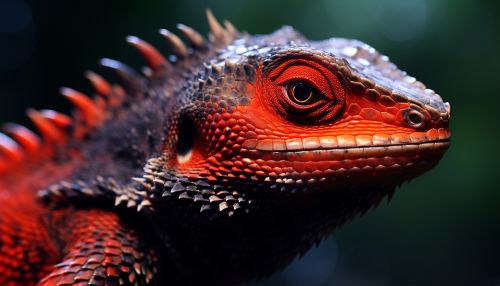Ectotherm
Definition and Overview
An ectotherm is an organism whose body temperature is primarily determined by its external environment. This term is derived from the Greek words "ektos", meaning outside, and "thermos", meaning heat. Ectotherms are also commonly referred to as "cold-blooded" animals, although this term is somewhat misleading as it implies that these animals are always cold, which is not the case.
Ectotherms include a wide range of organisms, including most fish, amphibians, reptiles, and invertebrates. These organisms are contrasted with endotherms, or "warm-blooded" animals, which maintain a constant body temperature regardless of their external environment.


Thermoregulation
Ectotherms rely on external heat sources to regulate their body temperature. They do this through a variety of behaviors, such as basking in the sun to warm up, or seeking shade or water to cool down. This method of thermoregulation is known as behavioral thermoregulation.
Ectotherms can also regulate their body temperature through physiological means. For example, some ectotherms can change the color of their skin to absorb more or less heat. Others can alter their metabolic rate to generate more or less internal heat.
Advantages and Disadvantages
Being an ectotherm has both advantages and disadvantages. One of the main advantages is that ectotherms require less food than endotherms. This is because maintaining a constant body temperature requires a lot of energy, which in turn requires a lot of food. Ectotherms, on the other hand, can survive on less food because they use less energy.
However, being an ectotherm also has its drawbacks. One of the main disadvantages is that ectotherms are more susceptible to changes in their external environment. If the temperature drops too low, for example, an ectotherm may become sluggish or even enter a state of torpor. Similarly, if the temperature rises too high, an ectotherm may overheat and die.
Evolution
The evolution of ectothermy is a topic of ongoing research. It is generally believed that the earliest animals were ectotherms, and that endothermy evolved later as a way for animals to become more active and to inhabit a wider range of environments.
However, some scientists argue that the first animals were actually endotherms, and that ectothermy evolved later as a way for animals to conserve energy. This is known as the "energy-saving" hypothesis.
Ectotherms in Human Culture
Ectotherms have played a significant role in human culture throughout history. In many cultures, reptiles and amphibians are revered as symbols of transformation and rebirth, due to their ability to shed their skin and their complex life cycles.
In modern times, many ectotherms are kept as pets, including reptiles such as snakes and lizards, and amphibians such as frogs and salamanders. Ectotherms are also important in scientific research, as their unique physiological characteristics make them useful models for studying topics such as thermoregulation and metabolism.
